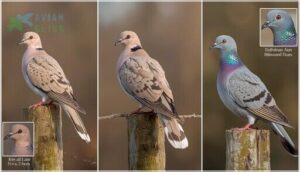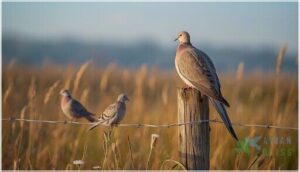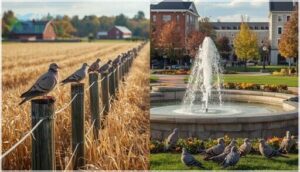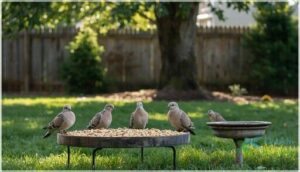This site is supported by our readers. We may earn a commission, at no cost to you, if you purchase through links.
Ohio’s skies carry more than just clouds and songbirds. Six species of doves and pigeons call this state home, from the familiar cooing of Mourning Doves in your backyard to the unexpected flash of white collar feathers on an introduced species that’s quietly expanding its range.
These grain-loving birds have adapted to Ohio’s diverse landscapes—nesting on apartment ledges, foraging in cornfields, and raising multiple broods throughout the breeding season.
Understanding which species you’re observing, where they prefer to settle, and what drives their behavior can transform a casual glance at a “common” bird into recognition of ecological patterns playing out in real time across the state.
Table Of Contents
- Key Takeaways
- Dove Species Found in Ohio
- Identifying Doves in Ohio
- Dove Habitats and Distribution in Ohio
- Dove Diet, Behavior, and Nesting
- Attracting and Observing Doves in Ohio
- Frequently Asked Questions (FAQs)
- What kind of doves live in Ohio?
- Are doves good to have in your yard?
- Are doves a good bird to have around?
- How do you identify a dove?
- What is the nesting behavior of Mourning Doves?
- How do Mourning Doves adapt to different habitats?
- What do Mourning Doves typically eat?
- How do Mourning Doves communicate with each other?
- What are the main threats to Mourning Doves in Ohio?
- Are doves in Ohio protected by law?
- Conclusion
Key Takeaways
- Ohio hosts six dove and pigeon species, with Mourning Doves being the most common year-round resident, while Eurasian Collared-Doves have successfully expanded their range since their late 20th-century introduction.
- You can identify Ohio’s doves by watching for key physical traits like the Mourning Dove’s pointed tail and soft cooing, the Eurasian Collared-Dove’s distinctive neck collar, and the Rock Pigeon’s iridescent feathers and urban habitat preference.
- These birds thrive in diverse habitats from city parks to farmland, with the highest populations concentrated in the Appalachian region and agricultural areas where seed availability and water sources remain consistent.
- Attracting doves to your yard requires simple adjustments like platform feeders with black sunflower seeds and shallow water basins, which can increase dove visits by up to 78% and improve nesting success when paired with minimal disturbance during breeding season.
Dove Species Found in Ohio
Several types of doves make their home in Ohio, each with unique traits to notice. You’ll find some birds are common year-round, while others are rare visitors.
Here’s a quick look at which dove species you might see across the state.
Mourning Dove Overview
Spotting a Mourning Dove in Ohio often means you’ve found the state’s most common dove. With their soft calls at dawn and dusk, classic Dove Identification highlights their pointed tails and gentle brown coloring.
Throughout the year, they nest in shrubs, adapt to varied habitats, and rely on seeds for a steady Mourning Dove diet—fueling steady Population Trends and frequent Hunter Harvests.
These birds often face challenges related to social and political issues.
Eurasian Collared-Dove Overview
After the Mourning Dove, the Eurasian Collared-Dove stands out as Ohio’s most successful introduced species. Following its Ohio introduction in the late 20th century, its rapid expansion created constant identification challenges. Look for that signature half collar on the nape.
This dove’s diet adaptation, ground-feeding habits, and flexible nesting behavior now weave it into Ohio’s blend of Dove and Pigeon Species.
Doves, like other birds, often carry significant symbolic meaning in various cultures.
Rock Pigeon Overview
Rock Pigeons are year-round residents across Ohio, showing up in 4% of summer and 7% of winter checklists. Unlike other dove and pigeon species, they’re non-native but thrive in urban environments. You’ll spot these chunky birds around towns, bridges, and parks. Their 32–37 cm bodies and iridescent neck feathers stand out in Ohio’s bird species collection.
What makes Rock Pigeons unforgettable:
- Their slate-gray bodies with two bold black wing bands catch your eye on every telephone wire.
- Urban habitats provide endless ledges for nesting behavior, from building facades to highway overpasses.
- Flocking patterns shift from small groups to large feeding aggregations depending on food availability.
- Feather coloration varies wildly—some show rusty browns while others gleam bluish-gray.
- Unlike true pigeon migration, they stay put year-round in habitats you know well.
Rare and Accidental Dove Species
While Rock Pigeons dominate Ohio’s urban landscape, certain dove species are rarely encountered. White-winged Doves and Common Ground Doves, for instance, have only been documented five times accidentally from 1990 to 2024. Most vagrant dove identifications occur during migration, particularly in southern counties where tailwinds create unexpected sightings. These rare bird species require verification methods, including photographic documentation, which accompanies 88% of accidental records.
Urban feeders and parks with mature trees act as habitat attractants for these transient visitors. Seasonal sightings peak during spring and fall migration windows when weather patterns shift. Population trends show micro-sightings increasing from 0.2 annually in the 1990s to 1–2 by the 2020s, reflecting improved bird identification efforts and citizen-science reporting in Ohio.
| Species | Ohio Status | Last Confirmed Sighting |
|---|---|---|
| White-winged Dove | Accidental | 2022 |
| Common Ground Dove | Accidental | Pre-2020 |
| Passenger Pigeon | Extinct (1914) | Historical misidentifications |
| Exotic Vagrants | Rare | 1–2 per decade |
| Eurasian Collared-Dove | Expanding Resident | Ongoing (6–9% annual increase) |
Identifying Doves in Ohio
Spotting doves in your backyard is one thing, but knowing exactly which species you’re looking at is another. Each dove in Ohio has distinct markings, colors, and behaviors that set it apart once you know what to watch for.
Let’s break down the key features that’ll help you tell one species from another with confidence.
Key Physical Characteristics
When you’re trying to nail dove identification in Ohio, a few key features make all the difference. Focus on these physical traits:
- Plumage coloration – Mourning Doves show soft pinkish-gray undersides, while Eurasian Collared-Doves lean toward sandy-gray tones and Rock Pigeons flash iridescent neck feathers in good light.
- Tail morphology – Mourning Doves have long, tapered tails; Eurasian Collared-Doves sport shorter, rounded ones.
- Wing markings – Look for black wing spots on Mourning Doves versus pale wing bars on Eurasian Collared-Doves.
Juvenile traits differ too, with young birds showing duller plumage and less-defined markings than adults.
Distinguishing Mourning Doves From Other Species
To separate Mourning Doves from other species, zero in on their slender, pointed tail and delicate gray-brown plumage variations—features that set them apart in any Bird Identification Guide. Size comparison helps: they’re smaller than Rock Pigeons and often Eurasian Collared-Doves.
Listen for their soft, drawn-out coo. Flight patterns show rapid wingbeats, and habitat overlap in fields or backyards makes Mourning Dove identification straightforward for Ohio observers.
Seasonal Appearance and Behavior Differences
As the year unfolds in Ohio, dove behavior and appearance tell their own story. You’ll notice:
- Breeding season shifts bring more Mourning Doves from March–September
- Winter flocking behavior clusters doves along rural and suburban edges
- Daily activity cycles shift with sunlight, especially at feeders
- Urban residency patterns keep Rock Pigeons visible year-round
- Seasonal movement patterns mark Eurasian Collared-Dove expansion
Dove Habitats and Distribution in Ohio
Doves in Ohio aren’t picky about where they live. You’ll find them in everything from busy city parks to quiet country fields, and their numbers shift quite a bit depending on where you’re in the state.
Let’s look at the main types of places these birds call home.
Urban and Suburban Locations
You’ll find the highest urban dove populations in Ohio’s cities and suburbs, where mourning doves have increased about 12% since 2015.
These backyards and parks now host thriving dove species in Ohio, with mourning doves reaching densities of 1.2–2.8 birds per hectare.
Urban dove populations benefit from consistent food resource access and reliable water sources, though light and noise impacts can shift their daily rhythms slightly.
Farmland and Grassland Habitats
Agricultural fields in Ohio provide some of the best dove and pigeon habitats. Mourning doves show a 14–22% higher foraging rate on crop availability like maize and millet compared to natural grasses.
Water sources on farms boost dove presence by 12–16%, while reduced mowing frequency increases nesting activity by 10–18%.
Crop diversification enhances species richness by 5–11% in agriculture edge habitats.
Population Density by Region
You’ll find the highest dove populations in Ohio’s Appalachian region, where forest edges support about 23 birds per square kilometer.
Urban dove populations around Columbus show strong seasonal migration patterns tied to bird distribution shifts, with 15–20 individuals per 100 hectares.
Agricultural land use in western counties maintains steady densities of 10–14 doves per square kilometer, while riparian zone habitats along southern waterways show concentrated nesting activity despite lower overall numbers.
Dove Diet, Behavior, and Nesting
Doves in Ohio are primarily seed-eaters with straightforward habits that make them easy to observe. Understanding what they eat, where they build their nests, and how they move through the seasons can help you recognize patterns in your own backyard.
Here’s what you need to know about their daily lives and reproductive behavior.
Foraging and Feeding Habits
When you watch dove species in Ohio, you’ll notice their feeding habits center on seeds. These birds prefer:
- Cultivated grains like corn and millet, making up over 60% of their diet in farmland settings
- Peak foraging times within two hours after sunrise, when temperatures stay cooler
- Ground-level feeding, pecking at scattered seeds on lawns and field margins
Urban foraging increases near feeders during late summer, and water needs rise during hot spells.
Nesting Sites and Breeding Patterns
After doves finish foraging, they shift to nesting and breeding. Mourning Doves pick open edge habitats, building simple cup-shaped nests in low shrubs or on the ground, with nest density averaging 0.8 nests per hectare during peak season. Their nesting success hits 56% in cropland areas. Breeding frequency runs 1–2 broods yearly, starting late April, with eggs hatching in 14 days.
| Species | Preferred Nesting Sites | Peak Breeding Period |
|---|---|---|
| Mourning Dove | Low shrubs, open edges | May–July |
| Eurasian Collared-Dove | Buildings, ledges | May–August |
| Rock Pigeon | Rooftops, urban structures | March–July |
Migration and Year-Round Presence
Once breeding wraps up, you’ll notice migration patterns shift. Mourning Doves arrive in early spring—March through April—then a second wave shows up in July and August. Some stick around southern Ohio into late December during mild winters.
Rock Pigeons stay year-round in cities, while Eurasian Collared-Doves remain sedentary across most counties.
Understanding these geographic range patterns makes birdwatching in Ohio more rewarding.
Attracting and Observing Doves in Ohio
Attracting doves to your yard doesn’t require complicated setups or specialized equipment. A few simple adjustments to your outdoor space can make it more welcoming to these birds while giving you better opportunities to watch them up close.
Here’s how you can draw in Ohio’s doves and improve your chances of observing their natural behaviors.
Providing Food and Water Sources
You can boost dove visits by up to 78% with supplemental feeding that includes black sunflower seeds in platform feeders or ground feeders. Pair this with water attractants—shallow basins work best—and you’ll extend foraging duration by roughly 28 minutes daily.
Nesting proximity to reliable water sources improves fledgling success by 22%, making habitat suitability stronger when seed and clean water are nearby.
Creating Suitable Nesting Environments
To support nesting habits, you can add shallow platform designs or ledges near habitat edge creation zones—mourning dove nesting habits favor semi-open spaces. Supply twigs and dried grasses as nesting material supply, and install predator protection strategies like baffles on posts.
Keeping disturbances low during May through July protects clutches. These bird nesting structures improve your bird habitat and increase fledgling success by roughly 15%.
Tips for Birdwatching and Identification
During early morning hours, you’ll see the most activity from mourning doves. Bring binoculars and a bird identification guide to spot wing patches and tail patterns. Practice ethical birding by keeping your distance—about 15 feet works well.
Listen for their soft cooing to confirm species. For photography tips, natural light at dawn captures their iridescent neck feathers best.
Frequently Asked Questions (FAQs)
What kind of doves live in Ohio?
You’ll find four dove species distribution across Ohio: the native Mourning Dove dominates observations, while Eurasian Collared-Doves and Rock Pigeons thrive year-round. White-winged Doves appear rarely during migration peaks.
Are doves good to have in your yard?
Yes, doves bring benefits like natural pest control and pleasant cooing. They’re gentle yard visitors that help with seed dispersal.
However, attracting doves can create some mess from droppings and scattered seeds under feeders.
Are doves a good bird to have around?
You might worry about noise pollution, but doves are gentle neighbors.
Their ecosystem role includes seed dispersal, and coexistence benefits outweigh minimal disease risk.
They improve your garden impact through natural pest control and backyard biodiversity.
How do you identify a dove?
You identify doves by examining plumage variations, size comparison, and vocalizations. Flight patterns help separate species, while habitat cues and neck markings—like the collared-dove’s black band—confirm identification during avian identification efforts.
What is the nesting behavior of Mourning Doves?
Despite their devotion, Mourning Doves build surprisingly flimsy nests—loose twigs barely woven together.
You’ll find these shallow platforms in shrubs or trees near open ground, where pairs share incubation duties for about two weeks.
How do Mourning Doves adapt to different habitats?
Mourning Doves show considerable habitat selection flexibility across Ohio’s landscapes.
They thrive in urban adaptation zones, agricultural impact areas, and edge habitats where water sources remain accessible, demonstrating resilient avian behavior despite ongoing habitat loss pressures.
What do Mourning Doves typically eat?
Seeds dominate the mourning dove diet—up to 95% during breeding season. You’ll find them foraging at sunrise and sunset, eating millet, corn, soybeans, and sunflower.
Crop consumption and dietary shifts reflect seed preferences based on regional availability.
How do Mourning Doves communicate with each other?
You’ll recognize mourning dove behavior through their distinctive vocal communication—those soft, melancholy coos—and visual signals like wing-flapping.
Bird calls and sounds, combined with wing claps during flight, create their social signals for territory and courtship.
What are the main threats to Mourning Doves in Ohio?
While Mourning Dove populations remain stable, they face ongoing challenges. Habitat loss from development, predation pressure by hawks and cats, window collisions, and regulated hunting all influence local dove conservation status and regional population dynamics.
Are doves in Ohio protected by law?
Yes, you’ll find most Ohio doves protected under federal law. Mourning Doves receive Migratory Bird Treaty Act coverage with hunting regulations, while Rock Pigeons lack federal protections, allowing nuisance control through local permits.
Conclusion
You might think doves in Ohio are just background noise, but watching them reveals surprising patterns—urban expansion routes, nesting site preferences, and feeding rhythms that shift with the seasons.
Whether you’re identifying the squared tail of a Mourning Dove or spotting the distinctive collar on an introduced species, each observation adds to your understanding of how these adaptable birds navigate Ohio’s changing landscapes.
Your backyard isn’t just a feeding station—it’s a front-row seat to ongoing ecological shifts.










